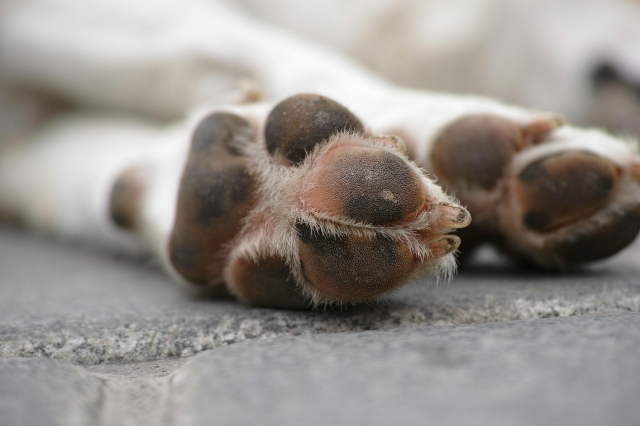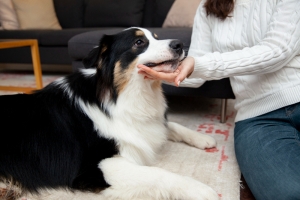Winter can be tough on your dog's paws, with cold temperatures, ice, and harsh chemicals posing risks to their health. To confirm your furry buddy stays calm and safe, it's essential to take extra care during the colder months. Regular cleaning and using protective gear are simple yet effective winter care tips that will help keep your dog's paws clean and injury-free.
In this article, we will explore the best practices for winter paw care that will keep your dog's paw healthy throughout the season.
Regular Paw Inspections
Frequent paw inspections are crucial for maintaining your dog's health, especially during winter. Ice, snow, and road salts can easily get trapped between their paw pads, causing irritation or injury.
According to AVMA, you must check your dog's paws regularly to catch any indication of injury or damage. It could be dry, cracked, and bleeding paw pads. It could happen due to a lame walk or ice accrual between the toes. To avoid accumulation of ice between the toes, simply clip the hair between their toes. It's better to avoid walking on the ice during this winter.
By routinely checking their paws, you can spot any cuts, cracks, or lodged debris before they become serious problems. Closely observe the spaces amid the toes and the condition of the pads. Early detection of issues ensures prompt treatment, keeping your dog's paws healthy and pain-free throughout the season.
What specific signs of frostbite or injury should I look for?
Look for indications of frostbite, like pale, gray, or blueish paw pads, cold and hard skin, or blisters. If your dog has swelling and redness in its paws and licks its paws excessively, these could indicate an injury or frostbite.
Cleaning Your Dog's Paws After Outdoor Exposure
Cleaning your dog's paws after outdoor exposure is essential to prevent irritation and keep them healthy. After each walk, gently wipe them with a damp fabric or use pet-safe wipes to remove dirt, ice, and road salt. Observe the areas amid the toes keenly, where debris can easily accumulate.
Animal Humane Society suggests washing your dog's paw with warm water if you are sure that it comes across de-icing chemicals. Rubbing off with a cloth won't be enough in this case. Make sure to dry them with a soft towel after washing their paws.
Regular cleaning not only protects against harmful chemicals but also minimizes the chances of infections. Additionally, consider using a mild dog-friendly paw balm after cleaning to moisturize and soothe their paws, ensuring they stay soft and protected.
Can regular household items, like a damp cloth, be used to clean paws?
Yes, regular household items like a damp cloth can be used to clean your dog's paws. Make sure it's clean and free from harmful chemicals. For better results, use pet-safe wipes or mild soap with water to thoroughly clean and rinse their paws.
Protective Gear for Winter Walks
Invest in high-quality dog boots designed to provide insulation and traction on icy surfaces, helping to prevent injuries and frostbite. Additionally, apply a paw balm or wax before walks to create a shield against salt and chemicals.
When choosing boots, ensure they fit properly and are comfortable for your dog, as ill-fitting gear can cause chafing or discomfort. By equipping your pet with appropriate winter gear, you can ensure they stay safe and enjoy their outdoor adventures even in challenging weather conditions.
Moisturizing and Conditioning Your Dog's Paws
According to Jax & Cali, moisturizing and conditioning your dog's paws are crucial for maintaining their health, especially in winter. While playing in the snow or walking, dogs' paws come in direct contact with snow, causing dryness. It may lead to dry and chapped paws. Therefore, applying a moisturizer is essential to maintain the softness and moisture of the paws.
After cleaning your dog's paws, apply a high-quality paw balm or conditioner to soothe and hydrate the pads. Look for products designed particularly for dogs, as they will be safe and effective for their sensitive skin.
A good dog moisturizer can provide essential protection and nourishment. Regular application helps prevent discomfort and keeps their paws supple and healthy. For ongoing care, incorporating a routine of moisturizing can make a considerable change in your dog's paw health.
Are there special constituents I should look for in paw moisturizers?
Yes, look for paw moisturizers with natural, safe ingredients like beeswax, shea butter, or coconut oil, which provide hydration and protection without harmful additives. Don't buy products with unnatural fragrances, colors, or alcohol, as these can annoy your dog's skin.
Hydration and Diet
Hydration and diet are vital in sustaining your dog's overall health and improving its paw condition. Ensure your dog has consistent access to fresh water to stay hydrated, as proper hydration helps maintain skin elasticity and prevent dryness.
According to the National Library of Medicine, a dog becomes thirsty after 15 minutes of exertion. However, it can't satisfy its thirst on its own, nor can you tell when it's thirsty. You have to take care of your dog's hydration and provide enough water to him.
A balanced diet loaded with essential fatty acids, such as those found in fish oil, can promote healthy skin and coat. Healthy skin and paws reduce the risk of cracked or irritated paws. Including nutrient-dense foods in their diet supports overall well-being and helps their body cope with the challenges of winter.
By focusing on hydration and a well-rounded diet, you contribute significantly to your dog's paw health and comfort.
Preventing Paw Injuries and Infections
Preventing paw injuries and infections involves several proactive steps to protect your dog's paws from harm. During walks, avoid areas with sharp objects or excessive salt and chemicals that could cause injuries or infections.
Use protective gear like dog boots or paw wax to protect their paws from rough terrain and harsh weather. Additionally, maintain good hygiene by keeping their paws clean and dry and ensuring their nails are trimmed to avoid painful splits or tears. By taking these precautions, you can significantly reduce the risk of paw injuries and infections.
When to Seek Veterinary Care
Knowing when to seek veterinary care for your dog's paws is essential for addressing potential issues promptly. According to WebMD, if your dog's paw suffers a small wound or cut, clean it with an antibacterial solution. Then, you must apply an antibacterial ointment and cover the wound with a light bandage. Don't ignore if the cut is deep; visit a veterinarian immediately.
Also, if you notice persistent signs of pain, like limping, excessive licking, swelling, or unusual changes in their paw pads, consult your vet. Additionally, if your dog shows symptoms of frostbite, like pale or bluish paw pads, trouble walking, or seems unusually distressed, seek professional help immediately.
Early intervention can prevent complications and ensure your dog receives the appropriate treatment for a swift recovery.
Ensuring Winter Paw Health
By following these winter care tips, you can help keep your dog's paws clean, healthy, and protected from the harsh elements. Regular inspections, proper cleaning, protective gear, and a balanced diet are key to preventing injuries and maintaining paw health. Stay attentive to discomfort or issues, and consult your veterinarian when needed.
With these practices, you'll ensure your furry friend enjoys winter walks comfortably and safely.






